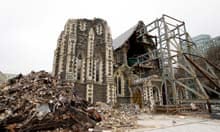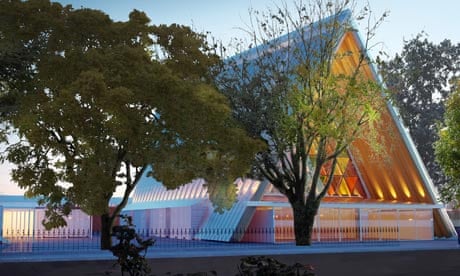With its celebration of the Gothic revival style and pride in being called that most English of cities, conservative Christchurch is an unusual place to host the world's first cardboard cathedral.
Two years and seven months after the February 2011 earthquake which physically and mentally rocked the foundations of Christchurch, killing 185 people, the Transitional Cathedral has opened its doors.
Designed by Japanese architect Shigeru Ban and delivered by Christchurch architectural firm Warren and Mahoney, the cardboard cathedral cost $5.3m, accommodates 700 people and has an expected life of 50 years. In a city without a town hall, and limited performance space, an expectant flock and the curious public are streaming in.

But in a broken place that has experienced so much loss – more than 220 heritage buildings have been demolished in a wasteland CBD where the wrecking ball is still swinging – it is hard for many to let go of a 132-year-old Gothic cathedral whose image was the city's brand in every postcard.
Much in evidence after the quake were pendants dangling tiny images of the rose window of the cathedral as people struggled to find a civic identity.
A bitter battle that has become personal rages over the fate of the old Christ Church cathedral with the Great Christchurch Buildings Trust. In one corner, wanting to restore the old cathedral, are the unlikely bedfellows Philip Burdon, a wealthy former National party cabinet minister, and former leftwing minister Jim Anderton. In the other is Bishop Victoria Matthews, referred to as the iron lady, who wants it demolished.
The Wizard of New Zealand, a political character and public speaker played by Ian Brackenbury Channell, used the cathedral as a prop in his public rants in which he compared Matthews to the damaged cathedral.
"She is in a very dangerous state, being seriously cracked and I can see no evidence that she can be made safe. Even if it were possible there would be no point in restoring her as she is as dull and bland as her cardboard cathedral," he said.
It was initially thought people had died when the quake struck the cathedral and the Canadian-born Matthews, relatively new to the job, had to wait anxious days for confirmation that there were no deaths.
She has earned some respect for having to endure misogynistic and xenophobic attacks and for showing strong leadership during the rebuild.
As the acting dean, Lynda Patterson, says, the old cathedral was caught up in the story of the Canterbury settlement, and "if you put 10 Cantabrians in a room you'll have at least 12 opinions". This is borne out in the pages of the local paper where those deeply into ancestral worship slug it out with a majority who have been polled and ticked the box for a contemporary cathedral some have likened to an upturned dinghy or "women's parts".
Campaigners battling to save the old cathedral are determined to keep fighting even though the latest court ruling allows the demolition to proceed.
Inside the new cathedral the space has a transcendental tranquility, with a Danish interior of white walls contrasting with a beige cardboard cross and a steeple of enormous cardboard tubes inserted with timber.
Shaped like an old-fashioned ridge tent, the cathedral is located next to the 185 White Chairs art installation representing the dead, and sits diagonally opposite the CTV site where 115 people perished.
The minimalist cathedral's frontage has a large trinity window with brightly coloured panels and faces north-south looking over Latimer Square, which accommodated so much drama on the day of the quake.
A triage area was set up at one end to tend to the injured as helicopters dropped off medical equipment into a panic of traumatised students, tourists and city workers who had fled there to shelter from falling buildings.
In about 10 years, the temporary cathedral will be handed over to St John's, an evangelical Anglican church demolished on the site after the quake.
Patterson says it had been tough being a refugee cathedral and sees the transitional cathedral as a sacred space in the city where the diocese can draw breath and "offer a place of worship in new circumstances".
Luckily the renowned choir and its music director are intact, and the opening has been celebrated by a series of packed concerts in a festival irreverently called Joyfully Un-Munted. It is hoped this will kick-start an income stream that has been impossible without a cathedral. The old one brought in $100,000 a year from the bell tower tours alone.
The arrival of the cardboard cathedral might take the heat off and allow for a more considered approach to the rebuild in the square, but with Aftermath, a pro-heritage documentary about to be aired, the raking over the rubble looks set to continue.
